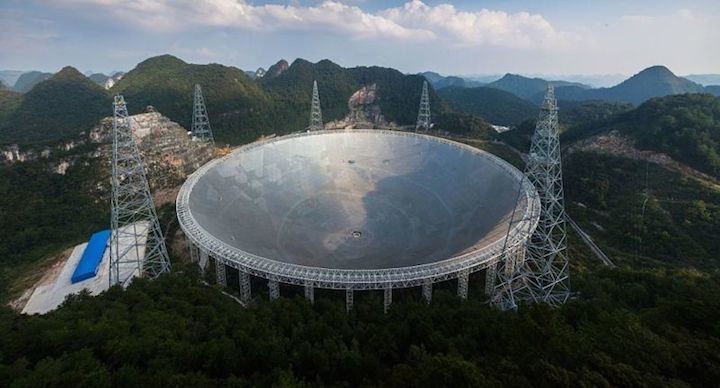During the second season of The Big Bang Theory, the aspiring actress Penny borrows money from Sheldon. Without a second thought, the theoretical physicist grabs a peanut brittle can in which he stores his extra money, and urges Penny to borrow as much as she wants. "This is money I'm not using," Sheldon explains.
Nick Suntzeff, an astronomer at Texas A&M University, recalled this episode when asked why no astronomers had yet taken a lucrative position to run the world's largest radio telescope, in China. The job pays about $1.2 million annually. "Now, that is an exaggeration," Suntzeff said of the TV show. "But I know many astronomers who would do such a thing. They want to be paid well, yes, but the money does not buy you telescope time, or access to supercomputers, or fund postdocs and graduate students."
China has built a staggeringly large instrument in the remote southern, mountainous region of the country called the Five hundred-meter Aperture Spherical Telescope, or FAST. The telescope measures nearly twice as large as the closest comparable facility in the world, the US-operated Arecibo radio telescope in Puerto Rico. Radio telescopes use a large, parabolic dish to collect radio waves from distant sources, such as pulsars and black holes—or even alien civilizations.
According to the South China Morning Post, the country is looking for a foreigner to run the observatory because no Chinese astronomer has the experience of running a facility of such size and complexity. The Chinese Academy of Sciences began advertising the position in western journals and job postings in May, but so far there have been no qualified applicants.
One reason is that the requirements are fairly strict: The candidate must have at least 20 years of previous experience in the field, and he or she must have taken a leading role in large-scale radio telescope project with extensive managerial experience. The candidate must also hold a professorship, or equally senior position, in a world-class research institute or university.
Only a few qualify
Suntzeff, an astronomer who helped lead the discovery of dark energy and is involved with construction of the optical Giant Magellan Telescope in Chile, said there are probably about 40 or so astronomers in the world who would qualify for such a job. Compared to other astronomy disciplines, radio astronomy is a relatively small field.
"I am sure they will find someone," he said. "But most astronomers in the United States do not like to work abroad. It was hard to get people to apply to work in La Serena, something I could never understand, considering how beautiful it is and how nice the Chilean people are."
Among the western community of astronomers there are also questions about the scientific purpose of the FAST telescope. As part of a recent National Science Foundation review of its facilities, US officials placed the similar Arecibo radio telescope near the bottom of its priorities list. This meant the United States would cease operations at the facility, which costs the government about $8 million annually, to free up money for newer facilities.
While FAST is larger than Arecibo, its effective size is not really 500 meters across because the instrument spends much of its time off zenith. Therefore the effective size is about 400 meters, compared to Arecibo's 300 meters. Arecibo also has the capability to transmit radio waves, making it an effective tool to identify targets such as near-Earth asteroids. FAST is only a passive instrument.
As part of their review, the main question US officials had for Arecibo concerned its science mission, in comparison to newer projects, such as the Large Synoptic Survey Telescope. Perhaps the exotic case for its existence was to identify signals from alien civilizations. While that would certainly be an historic finding that any astronomer would love to make, it seems an unlikely discovery. And that may be reason enough why no foreigner has yet moved to China, learned Chinese, and taken on the Byzantine bureaucracy of running the world's largest radio telescope.
Quelle: ars TECHNICA

